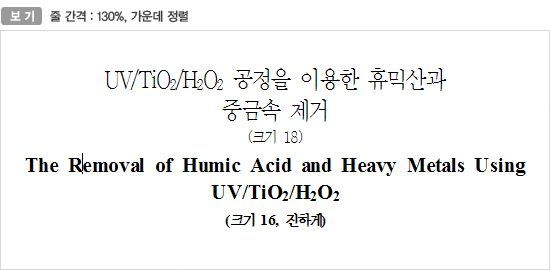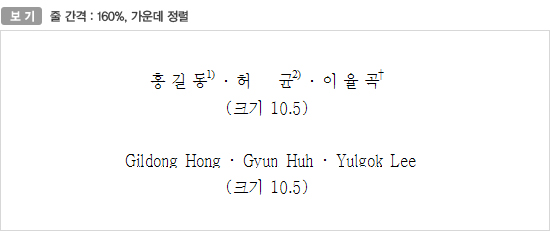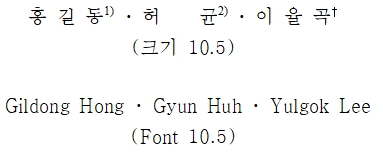논문작성규정
개정 2012. 12. 06.
개정 2021. 01. 01.
1. 원고 작성
- 1.1 작성 소프트웨어 및 용지
- 논문은 한글(한글과컴퓨터) 또는 마이크로소프트사 MS-Word를 사용하며, A4용지에 작성함을 원칙으로 한다.
- 1.2 글자와 줄간 간격
- 본문의 글자체는 신명조, 글자크기는 9.5 fonts, 줄 간격은 170%로 하는 것을 원칙으로 한다.
2. 논문의 체제
논문의 체제는 다음 순서를 원칙으로 한다.
(1) 제목 (국문논문은 국문, 영문 순으로 작성하고, 영문논문은 영문으로만 작성한다.)
(2) 저자명 (국문논문은 국문, 영문 순으로 작성하고, 영문논문은 영문으로만 작성한다.)
(3) 소속 및 직위 (국문 및 영문논문 모두 영문으로 작성한다.)
(4) 요지 (국문논문은 국문, 영문 요지 모두 작성하고, 영문논문은 영문 요지만 작성한다.)
(5) 주요어 (Keywords)
(6) 본문
(7) 감사의 글 (필요할 경우)
(8) 참고문헌
(9) 기호 및 단위 (그리스 기호, 영어 기호 차례로 알파벳 순)(필요할 경우)
(10) 부록 (필요할 경우)
3. 논문의 제목
(1) 논문의 주제목은 간단명료하게 표시하고 필요한 경우에는 부제목을 사용할 수 있다.
(2) 국문 논문일 경우 국문 제목 아래에 영문 제목을 병기하고, 영문 논문일 경우 영문 제목만 표기한다.
(3) 영문 제목의 각 단어 첫 자는 관사, 전치사 및 접속사를 제외하고 대문자로 적는다. 단, 문장의 첫 자는 대문자로 적는다.

4. 저자명
(1) 내국인의 경우 아래에 영문 표기를 병행한다.
(2) 영문논문의 경우 국문 저자명을 표기하지 않는다.

(3) 저자명 별로 오른쪽 어깨에 1), 2) 등을 표시한 후 논문 첫 페이지 하단 각주에 저자의 소속 및 직위를 영문으로 표기한다(단, 교신자에 한하여 †표시와 Corresponding Author: 이메일주소를 명기한다).
1) Associate Prof., Department of Civil Engineering, Hankuk University
2) Member, Department of Civil Engineering, Hankuk University
† Professor, Department of Civil Engineering, Hankuk University
(Corresponding Author : yglee@hanguk.ac.kr)
5. 요지
요지는 '요지' 또는 'Abstract'로 표기하고 국문과 영문 요지 모두 150~200단어 정도로 작성한다.

요 지
(크기 8.5)
본 연구에서는 매립장 침출수를 처리하기 위해 물리적인 차수기능만 하고 있는 차수벽체 대신 매립장 안에서 직접 정화 처리하여 지반으로 유출 시킬 수 있는 투수벽체의 시공에 대한 지반공학적 적용성을 평가하였다.
6. 주요어(Keywords)
국영문 요지의 아래에는 다음 보기와 같이 주요어(Keywords)를 4~6개 단어로 표기한다. 영문 Keyword의 첫 문자는 대문자로 한다.

주요어 : 휴믹산, 중금속, TiO2, 광촉매 반응 (크기 8.5)
7. 본문(장, 절의 구분)
본문의 장, 절은 보기와 같이 구분하여 표기하는 것을 원칙으로 한다


8. 표, 그림
(1) 표, 그림은 본문의 필요한 위치에 각각의 순서번호 및 제목을 나타내고 본문 뒤에 첨부하는 것을 원칙으로 한다.
(2) 표의 제목과 설명은 영문으로 표시한다. 표의 제목 첫 단어의 첫 문자만 대문자로 한다.

Table 5. General properties of TiO2(크기 8.5)
(3) 그림의 제목과 설명은 영문으로 표시한다. 그림의 제목 첫 단어의 첫 문자만 대문자로 한다.

Fig. 5. Schematic diagram of photocatalytic system (크기 8.5)
9. 단위
논문에 사용하는 단위는 국제단위계(SI 단위계)를 따른다. 필요할 경우는 다른 단위계에 의한 표기를 ( ) 안에 병기할 수 있다.
10. 참고문헌의 인용방법
본문에서 참고 문헌을 인용할 때에는 해당하는 내용 옆에 ‘( )’를 하고, 그 속에 저자와 발행년도를 적는다. 본문에 저자가 나타나 있는 경우에는 발행년도만을 적으며, 발행년도가 같은 동일 저자의 문헌이 두 개 이상일 경우에는 발행년도 뒤에 ‘a’, ‘b’ … 등을 부가하여 구분한다. 동일내용에 대해 인용문헌이 여러 개인 경우에 인용문헌의 구분은 세미콜론(;)으로 구분한다.
저자명은 국문문헌의 경우는 성과 이름 모두를 표기하고, 영문문헌은 Last Name을 표기한다. 인용문헌의 저자가 2인이면 2인 모두 표기하며, 3인 이상인 경우 제 1 저자명만을 사용하여 “Yen et al.”과 같이 표기한다. 이밖에 띄어쓰기, 문장부호 등의 사용은 다음 예제를 따른다.

이와 같은 내용은 홍길동(1986)의 결과이며, 이는 이전의 여러 연구(Yamada, 1977; Fisher, 1983a; Fisher, 1983b)의 연속이며, 최근 들어 많은 연구가 진행되고 있으나(Terzaghi & Peck, 1923; Hong, 2000; Yen et al., 2002), …
11. 참고문헌
본문에서 인용된 모든 참고문헌을 포함하는 것을 원칙으로 하며, 본문에서 인용되지 않은 문헌은 참고문헌에 포함시키지 않는다.
11.1 참고문헌 정리순서
참고문헌은 영문으로 표기하고 알파벳 순으로 작성한다. 영문으로 작성된 국문문헌의 경우 문장 끝에 (In Korean), 일문문헌의 경우 (In Japanese) 등과 같이 표기한다. 만약 참고문헌을 영문으로 표기할 수 없는 경우는 원문으로 작성하며, 국문 문헌, 일문 문헌 및 기타 언어 문헌 순으로 하며, 국문 문헌은 저자의 가나다 순으로, 일문 문헌은 50음도 순으로, 영문 문헌과 기타 언어 문헌은 알파벳 순으로 작성한다. 단, 한자로 작성된 일문 문헌은 가나다 순에 의한다. 제 1 저자의 성명이 같은 것들은 제 2 저자의 이름 순으로 정리하되, 이중에서 제 2 저자가 없는 것이 가장 우선한다. 저자가 3명 이상인 경우에도 유사한 방법으로 정리하며, 저자명이 일치하는 문헌들에 대하여는 출판년월이 빠른 것부터 정리한다. 출판년월 또한 같은 경우에는 문헌 제목의 가나다(알파벳) 순으로 정리한다.
11.2 참고문헌 표기방법
① 학술지 게재논문 : 번호, 저자(발행년도), 논문제목, 학술지명, 발행기관(국외인 경우), 권, 호, 인용 쪽

1. Kim, S. S., Jang, Y. S. and Koh, K. W. (1997), Study of the influence of mandrel on the smear zone and the variation of permeability, Journal of the Korean Geotechnical Society, Vol. 13, No. 5, pp. 45~57 (in Korean).
2. Robertson, A. P. and Leckie, J. O. (1999), Acid/base, copper binding and Cu2+/H+ exchange properties of a soil humic acid, an experimental and modeling study, Environmental Science and Technology, Vol. 33, No. 6, pp. 786~795.
② 학술회의지 게재논문 : 번호, 저자(발행년도), 논문제목, 학술회의지명, 발행기관(또는 출판사), 회의개최지(국외인 경우), 권, 인용 쪽

3. Lee, J. K., Kim, Y. S. and Kim, J. H. (2012), Rainfall-induced slope stability analysis on saturated and unsaturated soil, Korean Geo-Environmental Society Conference, Korean Geo-Environmental Society, pp. 67~70 (in Korean).
4. Hsu, G. J.(1980), On the correction of oceanographic applications. Proceedings of 17th International Conference of Coastal Engineering, ASCE, Sydney, Australia, pp. 709~724.
5. Wang, H. T.(1985), Temporal and spatial simulations of random ocean waves, Proceedings of 4th International Offshore Mechanics and Arctic Engineering Symposium, American Society of Mechanical Engineers, New York, Vol. 1, pp. 72~80.
③ 단행본 게재논문 : 번호, 저자(출판년도), 논문제목, 게재된 단행본명, 편집자, 권(있는 경우), 발행기관(또는 출판사), 출판지(국외인 경우), 인용 쪽

6. Blong, R. J.(1985), Gully sidewall development in New South Wales Australia, Soil Erosion and Conservation, El-Swanify, S. A., Moldenhauer W. C. and Lo A., eds., Soil Conservation Soc. Am., Ankeny, Iowa, pp. 574~584.
7. Lewellen, W. S.(1977), Use of invariant modelling, Handbook of Turbulence, Frost W., ed., Vol. 1, Plenum Press, New York, N.Y., pp. 237~280.
④ 저서 : 번호, 저자(출판년도), 저서명, 출판사, 출판지(국외의 경우), 인용 쪽. (영문표현이 없는 저서인 경우 원문으로 작성)

8. 정인준, 김상규 (1990), 토질역학, 동명사, pp. 100~121.
9. Norris, C. H. and Wibur, J. B.(1960), Elementary structural analysis, McGraw-Hill, N.Y. pp. 250~255.
⑤ 학위논문 : 번호, 저자(수여년도), 논문제목, 학위종류, 학위수여기관, 소재지(국외인 경우), 인용 쪽

10. Yu, W. D. (2009), A study on application of pre-surcharge horizontal drainage pipe system, Master's thesis, Hongik University. pp. 53~57 (in Korean).
11. Beltaos, S.(1974), Turbulent impinging jets, Ph D. dissertation, University of Alberta, Edmonton, Alberta, Canada, pp. 250~258.
⑥ 보고서 : 번호, 저자(출판년도), 보고서 제목, 보고서 종류(번호), 연구기관, 소재지(국외인 경우), 인용 쪽. (영문표현이 없는 보고서인 경우 원문으로 작성)

12. Park, J. B, Chun, Y. S., Park, Y. B., Sim, Y. J. and Lee, W. C. (2009), Study on the pile-head for the building foundation, Research 2009-08, Housing Institute, pp. 47~53 (in Korean).
13. Edinger, J. E., Brady, D. K. and Geyer, J. C.(1974), Heat exchange and transport in the environment. Report 14, EPRI Publication No. 74-049-00-3, Electric Power Res. Inst., Palo Alto, Calif., pp. 83~85.
14. Kananbolo, D. C. and Norville, H. S.(1995), The strength of new window glass plates using surface characteristics, Report, Glass Research and Testing Laboratory, Texas Tech University, Lubbock, Tex., pp. 256~259.
12. 기호(필요할 경우)
논문에 사용된 기호는 본문에 그 정의를 명확히 하여야 하고, 위에서 정한 위치에 전체 기호를 그리스 기호, 영문 기호 순서 그리고 알파벳 순서로 나열한다.
Instructions to Authors
1. Manuscript preparation
1.1 Software and Paper
Your manuscript shall be written on the A4-size paper using Hangul or MS-word.
1.2 Font and Spacing
The font of text is recommended to use Sinmyungcho in 9.5 size and 170% of spacing basically.
2. Manuscript Format
The manuscript format should follow the order below;
- (1) Title (Korean and English followed in Korean manuscript, English only in English manuscript.)
- (2) Author(s) (Korean and English followed in Korean manuscript, English only in English manuscript.)
- (3) Affiliation and personal title (Both in Korean and in English)
- (4) Abstract (Korean and English followed in Korean manuscript, English only in English manuscript.)
- (5) Keywords
- (6) Body
- (7) Acknowledgement (if needed)
- (8) References
- (9) Symbols and units (Greek symbols, English symbols in alphabetical order)(if needed)
- (10) Appendix (if needed)
3. Title of manuscript
- (1) The title of manuscript should be concise and informative and the sub-title can be used if necessary.
- (2) For the manuscript in Korean, the title in English should be followed immediately after the title in Korean. For the manuscript in English, leave the title in English only.
- (3) For the tile In English, the first letter of the sentence and vocabulary should be in a capital letter. The preposition, definite/indefinite article, and conjunction used in the sentence should be a lowercase(refer to the example below).


4. Name of Author
- (1) English name after Korean name should be written in Korean manuscript.
- (2) Do not write Korean name in English manuscript.


- (3)The author's personal title and affiliation should be displayed by 1), 2) in the footnote in the first page of the manuscript (The corresponding author is displayed with † and the email address should be provided).
1) Associate Prof., Department of Civil Engineering, Hankuk University
2) Member, Department of Civil Engineering, Hankuk University
† Professor, Department of Civil Engineering, Hankuk University
(Corresponding Author : yglee@hanguk.ac.kr)
5. Abstract
The abstract should be marked as 'Abstract' and written in Korean and English within the length of 150~200 words.

Abstract
(Font 8.5)
In this study, the geo-engineering applicability of the pervious wall which has a function of permeability after purification in the landfill site is evaluated to replace barrier wall which functions as a physical barrier only.
6. Keywords
4-6 keywords following the abstract should be presented and the first letter of each keyword should be written by a capital letter.

Keywords : Humic acid, Heavy metals, TiO2, Photocatalytic reaction(Font 8.5)
7. Body(Section and subsection)
The section and subsection should be divided as shown in example below.

3. Experiment result and consideration (Font 13.5)
3.1 Simultaneous removal of humic acid and heavy metals (Font 11)
3.1.1 Efficiency of humic acid and heavy metals removal (Font 10)
8. Tables, Figures
- (1)The tables and figures should be consecutively numbered and be properly located in the text.
- (2) The title of the table should be written in English. The first letter of the title is capitalized.

Table 5. General properties of TiO2(Font 8.5)
- (3) The title of the figure should be written in English. The first letter of the title is capitalized.

Fig. 5. Schematic diagram of photocatalytic system(Font 8.5)
9. Unit
It is desirable that units of measurements and abbreviation should follow The International System of Units(SI) except where the other unit system is more suitable with the parenthesis.
10. Reference citation
When the reference is cited in the text, the author and publication year should be written with parenthesis(e.g., (Yamada, 1977)). When the sentence starts with the author of the reference in the text, only the publication year should be written with the parenthesis (e.g., Hong Gil Dong(1986)). In case two or more references by one author are in same issued year, it should be differentiated by ‘a’, ‘b’ … behind the issued year. If there are several references for same citation, the references are differentiated by (;).
The full-name should be displayed when the Korean references are cited whereas only the last name should be displayed for the reference in English. For two authors, both authors should be displayed. For more than 3 authors, the first author only should be displayed such as “Yen et al.”. The following example shows the usage of spacing and punctuation.

This is the result of Hong Gil Dong(1986) and it is a succession from several studies(Yamada, 1977; Fisher, 1983a; Fisher, 1983b). Recently, there have been many more studies(Terzaghi & Peck, 1923; Hong, 2000; Yen et al., 2002), …
11. References
11.1 References list
The references should be written in English in alphabetical order. For the reference in Korean, it should be marked with (in Korean), for the reference in Japanese, it should be marked with (in Japanese). If it is impossible to write the reference in English, the reference should be listed in order of Korean, Japanese and other languages.
The Korean references should be arranged in order of 'Ga, Na, Da' of author's name, for Japanese reference, in 50 notes, for English and other languages, in alphabetical order. In case of Japanese reference written in Chinese letter, it should be displayed in order of 'Ga, Na, Da'. If the first author's name is same, it should be listed in order of the second author's name. The reference without the second author comes in first. In case of 3 or more authors, it should be listed in the same way. If the author's name is same, the references should be listed in order of publication year. If the publication year is same, it should be listed by title in 'Ga, Na, Da'(alphabetical) order.
11.2 References declare
① Journal article : Number, Author(Issued year), Title, Journal, Issuer(Abroad), Volume, No., Page

1. Kim, S. S., Jang, Y. S. and Koh, K. W. (1997), Study of the influence of mandrel on the smear zone and the variation of permeability, Journal of the Korean Geotechnical Society, Vol. 13, No. 5, pp. 45~57 (in Korean).
2. Robertson, A. P. and Leckie, J. O. (1999), Acid/base, copper binding and Cu2+/H+ exchange properties of a soil humic acid, an experimental and modeling study, Environmental Science and Technology, Vol. 33, No. 6, pp. 786~795.
② Article in conference journal : Number, Author(Issued year), Title, Journal, Issuer(Publisher), Venue(abroad), Volume, Page

3. Lee, J. K., Kim, Y. S. and Kim, J. H. (2012), Rainfall-induced slope stability analysis on saturated and unsaturated soil, Korean Geo-Environmental Society Conference, Korean Geo-Environmental Society, pp. 67~70 (in Korean).
4. Hsu, G. J.(1980), On the correction of oceanographic applications. Proceedings of 17th International Conference of Coastal Engineering, ASCE, Sydney, Australia, pp. 709~724.
5. Wang, H. T.(1985), Temporal and spatial simulations of random ocean waves, Proceedings of 4th International Offshore Mechanics and Arctic Engineering Symposium, American Society of Mechanical Engineers, New York, Vol. 1, pp. 72~80.
③ Article in single book : Number, Author(Issued year), Title, Book, Editor, Volume(if any), Issuer(Publisher), Pub. Place(Abroad), Page

6. Blong, R. J.(1985), Gully sidewall development in New South Wales Australia, Soil Erosion and Conservation, El-Swanify, S. A., Moldenhauer W. C. and Lo A., eds., Soil Conservation Soc. Am., Ankeny, Iowa, pp. 574~584.
7. Lewellen, W. S.(1977), Use of invariant modelling, Handbook of Turbulence, Frost W., ed., Vol. 1, Plenum Press, New York, N.Y., pp. 237~280.
④ Book : Number, Author(Issued year), Book, Publisher, Pub. Place(Abroad), Page (If the book has no English, it can be marked in original language.)

8. 정인준, 김상규 (1990), 토질역학, 동명사, pp. 100~121.
9. Norris, C. H. and Wibur, J. B.(1960), Elementary structural analysis, McGraw-Hill, N.Y. pp. 250~255.
⑤ Dissertation : Number, Author(Granted year), Title, Degree, Institution, Place(Abroad), Page

10. Yu, W. D. (2009), A study on application of pre-surcharge horizontal drainage pipe system, Master's thesis, Hongik University. pp. 53~57 (in Korean).
11. Beltaos, S.(1974), Turbulent impinging jets, Ph D. dissertation, University of Alberta, Edmonton, Alberta, Canada, pp. 250~258.
⑥ Report : Number, Author(Issued year), Title, Classification(No.), Laboratory, Place(Abroad), Page. (If the report has no English, it can be marked in original language.)

11. Park, J. B, Chun, Y. S., Park, Y. B., Sim, Y. J. and Lee, W. C. (2009), Study on the pile-head for the building foundation, Research 2009-08, Housing Institute, pp. 47~53 (in Korean).
12. Edinger, J. E., Brady, D. K. and Geyer, J. C.(1974), Heat exchange and transport in the environment. Report 14, EPRI Publication No. 74-049-00-3, Electric Power Res. Inst., Palo Alto, Calif., pp. 83~85.
13. Kananbolo, D. C. and Norville, H. S.(1995), The strength of new window glass plates using surface characteristics, Report, Glass Research and Testing Laboratory, Texas Tech University, Lubbock, Tex., pp. 256~259.
12. Symbols(If necessary)
The symbols in manuscript should have the accurate definition and should be listed in order of Greek, English alphabetically.

